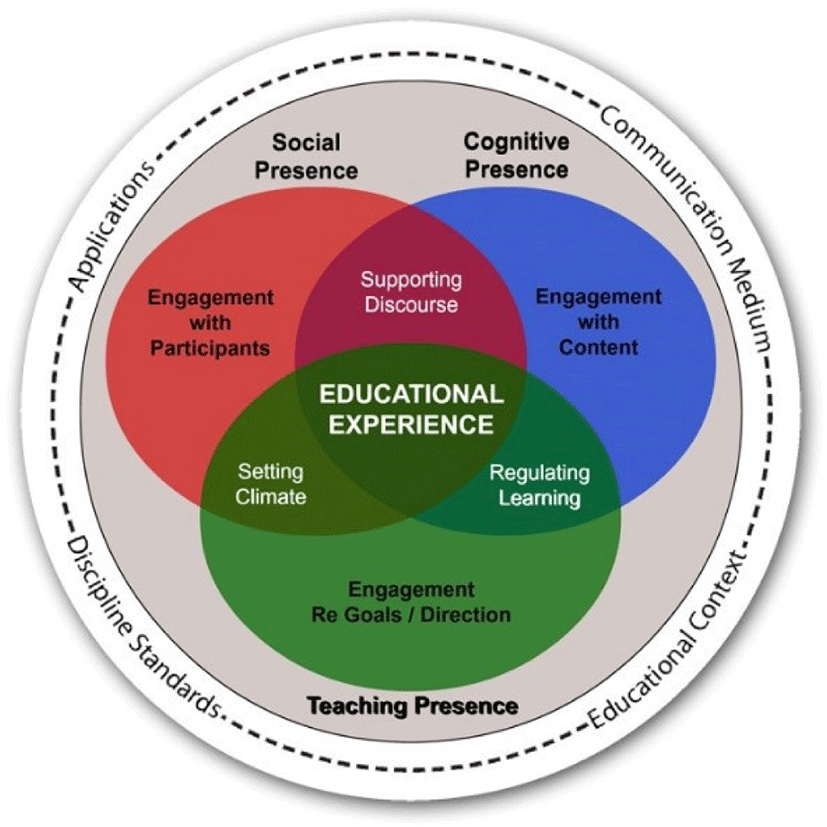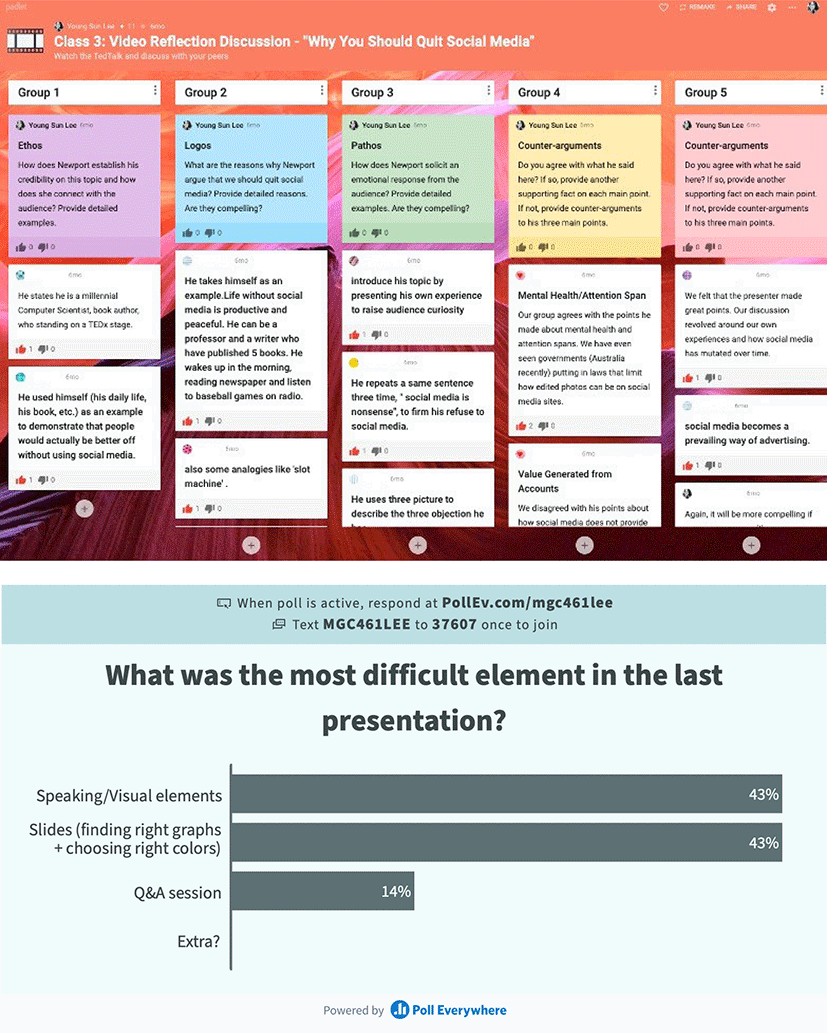Introduction
2020 was a challenging time for education throughout the world. Many instructors experienced unexpected difficulties in redesigning teaching methods from in-person to online or hybrid formats. In the business communication field, instructors worried that class contents and activities that were provided in online or hybrid courses that had been delivered in person previously would not be able to provide the same instructional outcomes without compromising students’ physical or psychological wellbeing. An important question about these challenges is whether the online or hybrid class format can be effective because people generally believe that public speaking courses should be taught in person.
This article addresses this worry and illustrates the potential of the online or hybrid format through a case study of courses that the author taught last year. By incorporating Garrison, Anderson, and Archer’s (1999) conceptual framework of Community of Inquiry (CoI) and pedagogy-based interactive tools, the author focused on designing a supportive learning community for students. The CoI theoretical framework addresses three core elements in particular: Cognitive, Social, and Teaching Presence. This article demonstrates the way each component can be applied to business communication courses in both online and hybrid formats during the pandemic. It also describes what specific tools the author used for each element and students’ impressions overall.
Case Description
Garrison et al.’s (1999) CoI is one of the widespread notions in online education that refers to facilitating meaningful learning communities. Each individual strives for careful support and collaboration within the learning community through well-intended communication, feedback, and developing mutual understanding. Initially, the CoI was established in John Dewey’s practical inquiry, who claimed that individual development is contingent upon community (Swan, Garrison, & Richardson, 2009). Community has been used generally in education and refers to its original definition by McMillan and Chavis (1986) as a sense of belonging. Thus, members have a shared trust that their needs will be met through their commitment to remain together. Later, the community addresses the cognitive or psychological links that physically distant students develop (Fiock, 2020). Many CoI scholars have attested that individual online students in a well-established learning community are willing to share their knowledge, collaborate with others, achieve group goals, and be content with their group efforts (Rovai, 2000; Wang, Sierra, & Folger, 2003).
As Figure 1 shows, the CoI framework is a process of creating a meaningful learning experience between teachers and students (or among students) through the interaction of the three core elements: Cognitive, social, and teaching presence.

Unlike other traditional lecture-based learning, business communication courses, particularly those in which speaking is emphasized heavily, require more active learning, such as student-teacher contact, cooperation among students, real time communication, and constructive feedback (McLain, 2019). Particularly in the online or hybrid courses during the pandemic, many students and educators experience a disconnect between students and their instructors, and students and their peers, and these experiences have raised concerns about online courses or programs. As the CoI framework was developed to build a strong online community and create a meaningful learning experience, many business communication educators who cope with these potential issues, such as teacher-student (or student-student) interaction, active learning, or group discussion, can benefit from the CoI principles and specific instructional guidelines for its implementation as a descriptive model.
Garrison et al. (1999) claimed that cognitive presence is an essential element in critical thinking, which is one of higher education’s greatest goals. Cognitive presence can be established by exchanging information, associating ideas, or applying new ideas. Specifically, students can apply their existing knowledge from previous experiences to real-world problems (Garrison et al., 1999) and construct meaning through continuous reflection (Anderson, Rourke, Garrison, & Archer, 2001). The use of asynchronous and text-based collaborative communication in the computer-supported group learning context may be vital to facilitate cognitive presence and achieve meaningful learning in higher education, as Newman (1996) argued.
A lack of physical interaction between teachers and students and among students is one of the potential difficulties that many instructors have pondered in online or hybrid courses during the pandemic. Social presence is one of the most pivotal elements in establishing a learning community (Fabro & Garrison, 1998), particularly when collaboration among students is crucial and sharing constructive feedback and engaging in candid discourse is expected in a class setting (Garrison et al., 1999). Participants in a learning community can achieve social presence when they experience their classmates’ personalities fully through the use of various communication contexts (Garrison et al., 1999). Social presence is critical because cognitive presence can be reinforced as well when individual students develop social presence by creating trust and collaborating as a learning community (Garrison et al., 1999). As other Computer-Mediated Communication (CMC) research has emphasized, establishing effective visual cues is essential in online or hybrid classes to maintain online students’ social presence.
While cognitive and social presence are based heavily on students’ perspectives, teaching presence refers to the instructors’ role and their virtual appearance. Through the course design and content, instructors can outline weekly topics and build a narrative statement for the students about what to consider in course assignments and activities (Fiock, 2020). This teaching presence can be achieved by providing regular course announcements with goals/objectives and regulating students’ learning methods.
Many similar instructional tools serve the same purpose. The tools that addressed in this article were among the options found from university resources. To create cognitive presence among students in business communication courses (both online and hybrid), instructors can consider using three tools: Panopto (to edit and post asynchronous lecture recordings), Padlet, and Poll Everywhere.
-
Panopto (asynchronous content): The author selected carefully what course content is needed to be delivered asynchronously. For example, students reviewed lecture recordings as much as they wished at their own pace and convenience, and then joined the synchronous class with questions or discussion points they tried to resolve with their classmates and instructor. Several light questions can be embedded in these recordings to ensure that they watch the lecture and understand the contents. Most of them are international students for whom English is not their first language. Students reported later that it was helpful that they could take more time to watch and understand the lecture materials independently. Hence, they were prepared fully for the synchronous class discussion.
-
Padlet: Students are required to review instructional materials before joining the class and prepare for synchronous discussion. Previously, students did not participate actively during the in-class discussion largely because they were reluctant to share their thoughts with the class directly. With Padlet, an online bulletin board, instructors can assign students to answer the pre-assigned questions as teams and summarize their consensus opinions on Padlet. Users can see immediately which team(s) contributed to the discussion they had with team members. Because their answers were updated synchronously, the instructor could tell which teams were having difficulty with the answers, visited them, and offered to help them accordingly (Figure 2).
-
Poll Everywhere: Instructors begin class by asking ice-breaker questions with this tool. Because the responses are anonymous, students join the polling and share their answers readily. Those answers can also become great resources for the instructor to call upon students who share interesting remarks and allow them to speak for a while. This tool encourages quiet students to contribute during class more naturally without requiring them to speak. Further, the tool is used to ask whether they have any remaining questions about the topic at the beginning or end of the class, so the instructor can understand the concepts about which the students feel less confident (Figure 2).

“I really like the asynchronous content as they provide great add on for the lectures. The amount of supplementary reading was more reasonable this term and provide comprehensive wrap up for the classes.”
“I love how the professor invite questions each class through Poll Everywhere. I think we were welcome to share any thoughts or questions during class discussion.”
“Rich materials, interactive and communicative atmosphere. I like the way we discuss collectively during the synchronous class using Padlet and Poll Everywhere. I learned where my peers have struggled and what other viewpoints they have through the active discussion.”
Through interactive online tools and careful curriculum design, online students still have many opportunities to develop friendships with their virtual classmates. Students are more willing to participate in class discussions and presentations once they have come to know one another better and built deeper relationships in the online course. To set the tone for risk-free communication, support discourse, and encourage collaboration among students, instructional tools such as Yellowdig Engage, Voicethread, and GoReact can help develop an engaging learning environment.
-
Yellowdig Engage: Outside of class, students can participate in the Yellowdig learning community to share their personal lives and favorite topics. Sometimes, students ask questions about the course assignments or materials and then discuss them with their classmates. Instructors can incorporate some light-weighted questions related to weekly topics from the class, so students still feel that it is part of the course work (Figure 3).
-
Voicethread: Students can use this tool to create a short introduction video at the beginning of the semester. Rather than making a brief introduction during class, they visit Blackboard and post their pre-recorded introduction video about themselves. Students seemed to enjoy using the new tool and introduced themselves to their classmates virtually before seeing each other in an online class. Instructors can make brief comments about their interesting remarks and skim students’ interests before class begins.
-
GoReact: This is an online recording tool that allows instructors to make specific suggestions with a time-stamped comment option. It helps students understand areas for improvement, so they perform better in their subsequent presentations. To build social presence among students, the instructor may require participants to respond to their classmates’ presentations by sharing positive and negative feedback. Some students feel uncomfortable about allowing their classmates to watch their videos. However, they generally watch more exemplary presentations and learn what constitutes a good presentation and apply it to their own future presentations (Figure 3).

“I really like GoReact. I could rewatch myself and see comments from classmates and professor which contain more details on my presentation. Because it has specific time stamp, I could see which area I particularly need to improve.”
“Being a Zoom classroom participant, I believe that Yellowdig evolves our class participation into real engagement by enabling us to have the opportunity to learn more about each other from knowing small things they shared. It keeps us from feeling ‘zoomed out’ during this pandemic.”
“I really enjoy Yellowdig community. It was such a new experience for me. We could share things happening in our lives as if we were next to each other. It is a way of building relationships, creating a bond and encouraging engagement. It enhanced the learning from the classroom while adding on learning outside the course content.”
Through the course announcements, weekly overviews, feedback to students, and course activities, instructors can deliver a narrative story about course content carefully and establish teaching presence. The methods that the author used for the online or hybrid class were the instructor’s welcome video, video/audio feedback, and instructor’s open feedback to the entire class.
-
Instructor’s welcome video: Instructors can create a short welcome video that describes the course and its objectives. Students may feel somewhat afraid when they come to class on the first day (particularly if they are on Zoom) because they have not met the instructor before. The instructor can create a welcoming atmosphere and let them know that s/he is supportive and encouraging, including advising them where to ask questions during the semester and assuring students that their concerns will be heard (Figure 4).
-
Video/audio feedback: Instructors can consider using the video/audio option to give feedback on students’ performance (such as presentations). Because of the lack of human interaction in written feedback, some of the students may find it harsher than the instructor intended. Therefore, students may become defensive rather than receptive to the comments. When instructors use video or audio commentaries to share feedback instead, students feel that they are having a conversation with their professor. If the instructor’s voice and video demonstrate a supportive tone and facial expressions, students feel that s/he wants to help them rather than criticize their mistakes. It may take more time for an instructor to make an audio/video recording, but it reduces potential miscommunications between students and the instructor (Figure 4).
-
Instructor’s open comments to the entire class: Students see not only their classmates’ presentation videos and all of the classmates’ feedback on their video; they also see all of the instructor’s comments on everyone’s presentation video. Instructors can compliment students on their good efforts and offer specific comments and suggestions for improvement. Because students read other classmates’ feedback on their video, the instructor can echo what the classmates say and explain his/her own viewpoint. It gives the impression that there are suggestions upon which all agree; thus, students become less defensive about reading the instructor’s comments simply because it is not just one person’s remark. Further, students generally want to do better than their peers, so it motivates them to invest more effort in their future performance.

“I think the instructor made herself very available which is really important in online classes. I loved the creativity when it comes to sharing her feedback using video option for my presentation. I felt like we are having a conversation.”
“The professor was inviting and made an online experience feel just as connected as in person. She made us feel welcome and gave great examples to back up content when needed, as well as challenging us to go above and beyond to better our learning and understanding.”
Conclusion
While this case study does not provide generalizable empirical evidence, my students’ grades overall had slightly better average final scores (89.7%) compared with the previous year (89.1%), which shows that the online course design had no adverse outcomes, nor did it compare unfavorably with in-person courses. Moreover, students’ reflections about me and the course were also much more positive than those in the previous year. With a 5-Likert scale, both the instructor evaluation (4.97) and course evaluation (4.83) increased compared to the previous year’s evaluations (4.76 and 4.54, respectively).
The majority of students showed appreciation for their instructor’s efforts to keep them engaged throughout the semester. Although some of the course design elements required students to spend more time reviewing the contents and participating in various platforms, they understood why they were asked to do so. In the course evaluations, many indicated that they understood that the instructor was inviting their contribution and participation. They reported that the online learning experience was just as connected as in-person and acknowledged that the course helped them keep the class interactive and offered them opportunities to support each other.
The key to success compared with the last term was increasing students’ motivation to learn and engage with others in the class. Through the CoI framework and pedagogy-based technology, building a supportive learning community can be accomplished online just as easily as it can in a face-to-face course. This study contributes to instructors who consider diverse approaches for effective business communication courses that serve different needs and purposes. I hope many business communication instructors can view this challenge as a potential opportunity to facilitate higher education students’ learning.






